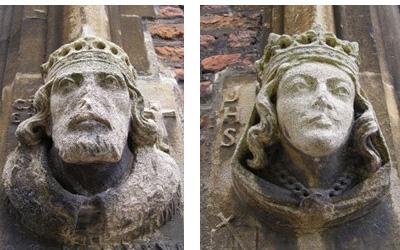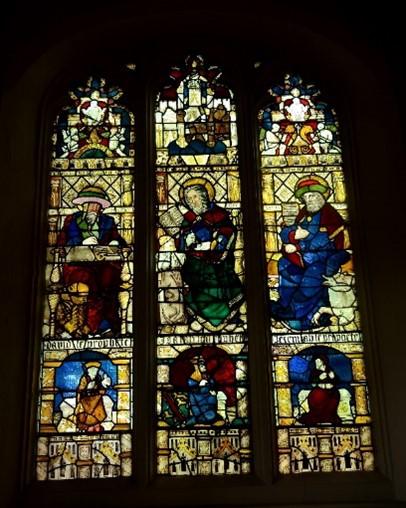This impressive ancient stone and brick building is the borough’s oldest. Now Grade II* listed, All Hallows Church is the original parish church for Tottenham, founded in 1150. The medieval church was built as ‘All Saints’ but was re-dedicated to All Hallows in the 15th century. On entering the church through the Tudor brick castellated porch, bestowed by Sir William Compton in 1514 as Lord of the Manor at Bruce Castle, one is reminded of the early connections with Scotland. On either side of the door are 20th century sculpted heads of King David I of Scotland and Queen Maud (or Margaret). Their descendants were members of the de Brus (or Bruce) family and held the manor of Tottenham.

(King David I of Scotland and Queen Maud (or Margaret). From the collections of and © Bruce Castle Museum and Archive)
The oldest parts of the present building are the lower levels of the church tower, dating from the early 14th century, and the columns of the church nave inside. The original medieval church consisted of a tower, nave, aisles and porch. The roof was six bays long. The whole of the present east end and the barrel vault roof of the nave are the work of the eminent Victorian architect William Butterfield who restored the church between 1875-1877. Many others have, of course, shaped the social, architectural and spiritual history of this important church, parish and the community – with some highlighted here.

(Tottenham Church by Henrietta Townsend of Bruce Castle, 1774. From the collections of and © Bruce Castle Museum and Archive)
William Bedwell (1561-1632)
If you wanted to learn the Arabic language 400 years ago, you wouldn’t find the best teacher at a prestigious school or historic university. You would find him at his vicarage, on what is now White Hart Lane in Tottenham.
William Bedwell (1563-1632) was the most important English Arabist of his time as well as a mathematician. He had also been one of the translators appointed for the King James Bible. From 1607 until his death, he was also the vicar of Tottenham at All Hallows Church, around the corner from Bruce Castle. There is little trace of Bedwell in Tottenham today, but evidence found in his manuscripts, books and letters allows us to piece together his story. In a time before printed textbooks and dictionaries, Bedwell put Tottenham on the map as a European centre of Arabic learning.
In a time before printed textbooks and dictionaries, Bedwell put Tottenham on the map as a European centre of Arabic learning, and also wrote and published the first history of Tottenham printed in 1631 and called ‘Brief History of Tottenham, with the Antient Poem of The Turnament of Tottenham’. (Read more about ‘The Tournament of Tottenham’)

(From the collections of and © Bruce Castle Museum and Archive)
Early Black presence - Walter Anberey (1609 - ?)
The parish registers of 1610 from All Hallows Church in Tottenham reveal the earliest evidence of the Black presence in Haringey. His small biography says: ‘Walter Anberey, the son of Nosser Anberey, borne in the kingdom of Dungala in Africa was baptised upon the third day of February...’. We know from other records that Walter was in a position of authority in the parish and could represent the vicar – William Bedwell. We also know that through Bedwell’s writing in Arabic that he was using phrases that showed he was speaking in Arabic with someone. Could this be Walter?
A number of other records survive throughout the 1700s to include men and women, young and old, named and un-named individuals. We even learn of married couples from entries in a burial register from All Hallows of Sarah and Robert Claret. Sarah died on 6th April 1760. Other than being described as Black, nothing more is known about her life. Robert Claret died in 1762 aged 65 years. Their names are recorded forever, together, in the community where they lived. These are likely to be the names given to them by slave owners. We do not know their African names. Their original identities have been stripped. Did they live as a free family or as slaves serving a household? If slaves, who did they belong to? Most enslaved families were constantly separated as slaves were sold on.
The survival of the names of these individuals demonstrates the wide displacement of people removed from their homes because of Britain’s activities in the slave trade. These people are the living embodiment of the riches and profits made for others from the successful transactions of this trade. Where did these people come from? From Africa? Or taken from the Caribbean back to England? How did they get here? Were they cruelly treated? Were they escaped slaves? These captured Africans had their own families, their own lives, their own histories – even if this information has not been recorded.

(From the parish registers of All Hallows Church, 1610. In the collections of London Metropolitan Archives)
Artwork at All Hallows
The interior of All Hallows showcases some exquisite examples of art, craft and design from across the centuries. Here are the highlights:
Stained glass
Most of the stained glass windows are crafted by Alexander Gibbs (c.1832-1886) or the studio of Alexander Gibbs, whose company was amongst the eleven major stained glass suppliers of the Victorian period. Gibbs was a friend of the eminent architect William Butterfield who was responsible for the Victorian restoration and expansion of the church at All Hallows in 1875-7. Butterfield is buried in nearby Tottenham Cemetery, by the Church Path; his grave was designed by himself in Gothic Revival style and is Grade II listed. The vicar of All Hallows Rev’d Alexander Wilson was a close friend of William Butterfield and had commissioned and paid for the work by Butterfield at the church. Both he and his wife are buried in a matching grave not far from Butterfield’s, which was also designed by him.

(Stained glass window by Alexander Gibb at All Hallows. Photographer © John Salmon)
At the north-west point of the church, amongst the other windows by Gibbs, there is also a rare example of a late 16th century French stained glass. As many churches were destroyed during the French Revolution, this glass was salvaged and brought over to Britain during the short truce of the Treaty of Amiens. It was presented to the church in 1807 by Sir John Eardley-Wilmot of Bruce Castle.

(The French stained glass bestowed on All Hallows by John Eardley- Wilmot of Bruce Castle in 1807. From the collections of Bruce Castle Museum and Archive. Photograph © Henry Jacobs)
Another small stained glass window can be found to the left on entering the church. It shows the Adoration of the Magi, and includes the Three Kings including the Black king Balthazar. The artist of this glass is unknown.

(From the collections of Bruce Castle Museum and Archive. Photographer and © Henry Jacobs)
A local witch? Elizabeth Fleming (died 1790)
One of the old local history books of Tottenham by Fisk says: “Much has been written about the room over the Church porch: in it Elizabeth Fleming lived for 40 years. In many titbits of Tottenham history one comes across the old story which is told that this woman died March 17, 1790, aged 100 years. She is believed to have been a witch.”
He doesn’t elaborate further or let on what might have happened for her to be called a witch. The room above the Porch at All Hallows – at the main entrance to the church - was originally used from the Tudor period as a schoolroom to teach a small group of boys. In the centuries that followed it was used to house poor inhabitants of the Parish - like Elizabeth. The room was very small. Maybe she kept herself to herself, positioning herself on the margins of society? Perhaps her longevity made her stand out as different? As an older woman, she would have been seen as having the benefit of experience and wisdom - often where the ‘magic’ associated with witches comes from.
Living above the entrance to the church, she was on the threshold of this sacred space, neighbouring the graveyard and living outside the main community. We can see how rumour, gossip and speculation can conjure such stories about someone they may not have known very well. Checking the burial registers for the church for 1790, there is one Elizabeth Fleming who was buried in September that year but her recorded age was 76 years.

Location
Tottenham’s Oldest Building
Church Lane, London
Tottenham
N17 7AA
United Kingdom